A 70mm film format consisting of 12 horizontal rows of images and 12 soundtracks, developed for use in the Panacolor cartridge film projector for home viewing.
Film Explorer

A section of the feature film Beware! The Blob (1972), directed by and starring Larry Hagman. This print was used in a Panacolor cartridge and film projector for viewing in hotel rooms.
Courtesy of John Wallace, Tangible Media Collection, Ithaca, NY, United States.
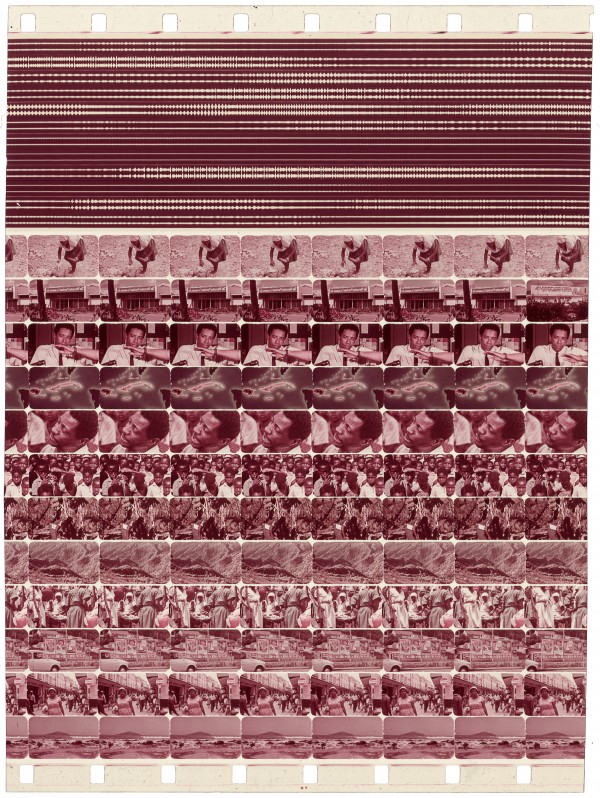
Unidentified film, c.1970s. This example, on Eastmancolor print stock, shows signs of heavy color fading.
Cinémathèque française, Paris, France.
Identification
Unknown: described as being “approximately [or] slightly larger than Super 8”.
Vertical perforations are present, but they are not necessary for transport due to the capstan advancement mechanism in the projector.
Color
“EASTMAN SAFETY FILM” is present on samples consulted.
1
Standard Eastmancolor print stock. Most surviving examples are likely to be heavily color faded.
12 variable-area optical soundtracks were synchronized with each of the 12 rows of images.
Color
History
The Panacolor film format was a 70mm format developed for proprietary use in a viewing device made by Panacolor Inc., a company established in 1957 to produce color film release prints (Anon., 1957: p. 10). In 1963, the company entered into the burgeoning film cartridge business, partnering with Zeiss Ikon of West Germany to develop a new type of film projector, which was designed to resemble a 19-inch television set (Anon., 1963: p. 24). The Panacolor cartridge contained 300 ft of 70mm film, capable of playing a feature film of up to two hours in length, or six separate segments, each 20 minutes in length. The film itself contained 12 rows of Super 8-sized images and 12 synchronized soundtracks (Anon., 1968). Leon W. Wells filed patents for the film format, cartridge and projector on behalf of Panopix Research Inc., a subsidiary of Panacolor Inc.
Panacolor demonstrated a prototype of its “magazine projector” for stockholders in 1964, envisioning it for home, commercial and educational use (Anon., 1964b: p. 19). Ahead of a demo at the Cannes Film Festival in 1968, the system was promoted for its potential to bring films to more remote areas of the world with limited, or no, access to theaters (Anon., 1968c: p. 17). That same year, Gulf & Western Industries Inc., entered into an agreement with Panacolor to obtain marketing and distribution rights for the projector. (Anon., 1968d: p 8). Du Art Film Laboratories built a processing machine for the Panacolor 70mm film format (Anon., 1968a). Panacolor established a processing facility in Lodi, New Jersey, and priced the projector at $595, the equivalent of $5,384 in 2024 (Fox, 1968: p. 58).
The next few years were spent promoting the projector and seeking agreements to print and distribute films. In 1971, Sensory Devices, Inc. landed a three-year contract to distribute films in bars, restaurants and hotels in the United States and Canada (Anon., 1971: p. 19). They referred to the system as the “Zeiss-Ikon Panacolor Mini-Theater" and sought out films of any rating (Anon., 1972: p. 23). The company had some success acquiring films, and the projector made its debut at the Commodore Hotel in New York in 1972. Hotel guests had the option of renting one of 25 films, for $4.50 each. The chosen film was inserted and locked into the projector before being rolled into the patron’s room (Anon., 1972: pp. 2, 70). While a variety of titles were offered, softcore adult films were the most popular by far, ushering in a new era for pay-per-view in the hotel industry (Alilunas, 2016: p. 55). The system was never formally introduced in bars or restaurants.
In 1973, Panacolor entered into an agreement with 20th-Century Fox to distribute the projector and cassettes to hotels in the United Kingdom. It was introduced to four London hotels as the “Pik-A-Movie” system and it was reported that it was already available in 21 Sheraton hotels as well. (Anon.,1973c: p.61). By this time, Panacolor was pursuing deals in Hong Kong, Malaysia, Singapore, Taiwan and Thailand (Anon., 1973a: p. 17). They successfully brokered a contract with a distributor in South Africa, which was a promising location since the country did not have television at the time (Anon., 1973b: p. 51). However, by late 1973, it seems that none of these deals were moving forward. 20th-Century Fox chose not to continue their relationship with Panacolor and the “Pik-A-Movie” system, for which they had also contributed seed money (Anon., 1973e: p. 28).
Despite the projector’s novel design and capabilities, it ultimately could not compete long term in a rapidly evolving market, with many different cartridge technologies and designs becoming available before videotape eventually took over (Kindred, 1972: p. 55). Panacolor struggled financially for the next year, and in 1974 Film Corp. gained a 48 per cent stake in the company (Anon., 1975: p. 13). In a 1977 press release, regarding an agreement between Film Corp. and Napcolour, Panacolor Inc. was referred to as a “general mail-order merchandiser” based in Philadelphia, indicating they had abandoned their 70mm format and the film cartridge business entirely (Anon., 1977: p. 17).
Selected Filmography
Feature film photographed on 65mm and originally released in 35mm and standard 70mm prints. The film was available to guests at the Commodore Hotel in New York City.
Feature film photographed on 65mm and originally released in 35mm and standard 70mm prints. The film was available to guests at the Commodore Hotel in New York City.
Feature film originally photographed and released in 35mm.
Feature film originally photographed and released in 35mm.
Feature film originally photographed and released in 35mm. It was listed as one of six initial offerings in the London hotel agreement.
Feature film originally photographed and released in 35mm. It was listed as one of six initial offerings in the London hotel agreement.
Feature film originally photographed and released in 35mm.
Feature film originally photographed and released in 35mm.
Softcore sexploitation film originally photographed and released in 35mm. This genre of films offered at the Commodore Hotel was the most popular among guests.
Softcore sexploitation film originally photographed and released in 35mm. This genre of films offered at the Commodore Hotel was the most popular among guests.
Technology
Panacolor film contained 12 rows of images and 12 corresponding soundtracks printed on 70mm Kodak film stock. These images, each line of which was referred to as a track, were displayed horizontally on the film rather than vertically, and grouped separately from the soundtracks.The frame size was slightly larger than Super 8 and was based on the widescreen 1.5:1 ratio (Anon., 1968b: p. 835).
The format was designed specifically for the Panacolor cartridge film projector, at the time touted as a “radical innovation” in sound film projection (Deafer, 1968: p. 29). The 3½-lb (1.59kg) cassette contained 300 ft of film, allowed for up to 2 hours of uninterrupted viewing and was small enough to hold in one hand. The projector was notable for using a new “prism core” assembly containing 12 symmetrical lenses connected to an optical prism, instead of a conventional shutter system (Anon., 1968b: p. 835). It used a capstan mechanism, common in videotape transport, to advance the film. This offered the potential to extend the life of the print in the cartridge and it also resulted in a quieter viewing experience compared to standard pull-down claw mechanisms. While the two rows of perforations on the film were not necessary for transport, they did serve to synchronize the optical faces of the rotating prism as it tracked the continuously moving image frames. This left 93 per cent of the film area available to contain audio-visual information, in contrast to the 60 per cent on 8mm film (Fox, 1968: p. 58).
At the press of a button, the film was automatically threaded onto the take-up reel and the projector ran the film horizontally at 24 fps until reaching the end of the first track. An inaudible signal on the soundtrack prompted the projector to step down to the next row of images and sound tracks and reverse the direction of transport. This process continued with each track until the end of the 12th track, at which point the projector shut off. An accompanying remote control featured pause, rewind, fast-forward and focusing capabilities. Users could also jump forward, or backward, from track to track (Anon., 1968b: p. 835). The projector contained a 7¼ in x 10½ in (184.2mm x 266.7mm) screen, intended to be similar to a television screen (Desfor, 1968: p. 29). There was also the option to switch to front-projection, for use with a separate movie screen.
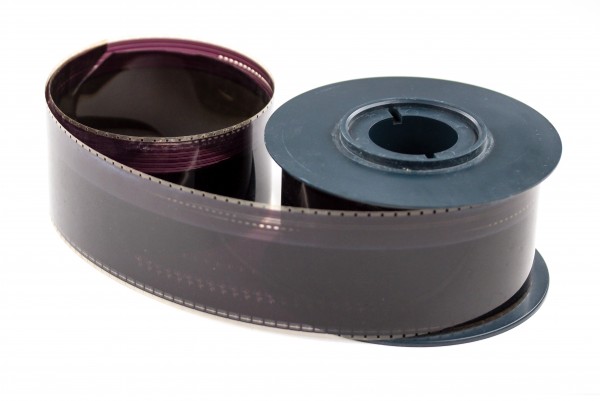
The film Beware! The Blob (1972), wrapped on the spool that fits inside the Panacolor cartridge.
Courtesy of John Wallace, Tangible Media Collection, Ithaca, NY, United States.
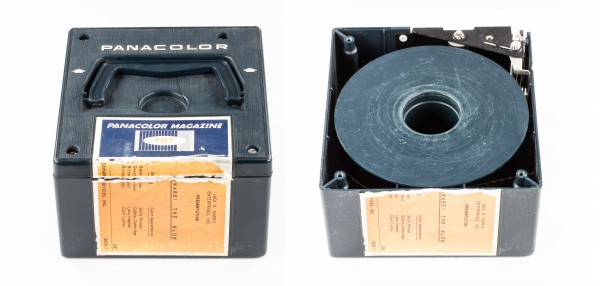
Panacolor magazine cartridge (with and without lid), with label that contains credits for Beware! The Blob (1972).
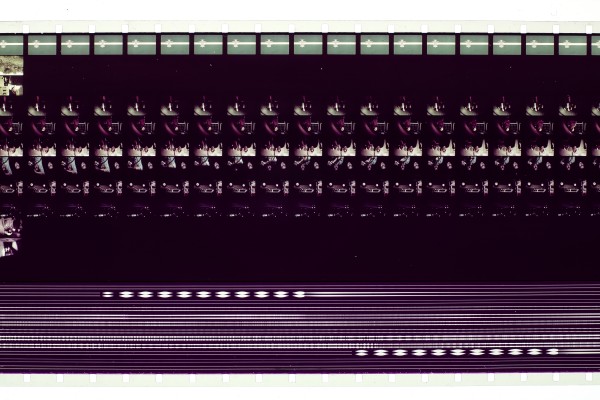
Inaudible reversal signals were present at alternate ends of each sound track. These prompted the viewing device to step down to the next row of images and sound tracks and reverse the direction of transport, for a seamless viewing experience.
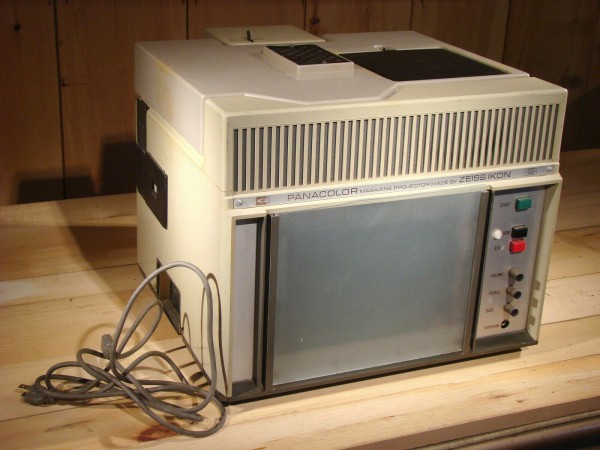
The Panacolor Pik-A-Movie projector, manufactured by Zeiss Ikon, featuring a screen on the front and control panel on the right. The cartridge was inserted in the top opening of the projector.
References
Alilunas, Peter (2016). Smutty Little Movies: The Creation and Regulation of Adult Video. Berkeley, CA: University of California Press
Anon. (1957). “New Incorporations”. The Hollywood Reporter, March 8, 1957.
Anon. (1963). “Panacolor to Produce Zeiss-Ikon Projectors with Cartridge-Fed Film”. Wall Street Journal, September 18, 1963.
Anon. (1964a). “Pictures: Leon Wells is Out”. Variety, February 5, 1964.
Anon. (1964b). “Pictures: Panacolor's Meeting Points Up Projector”. Variety, June 24, 1964.
Anon. (1968a). “Du Art 1967 Lab Sales Up while Net is Decreased”. Boxoffice, April 8, 1968.
Anon. (1968b). “Photokina 1968”. American Cinematographer, 49:11 (November 1): p. 835.
Anon. (1968c). “Pictures: Panacolor Demo due at Cannes”. Variety, May 15, 1968.
Anon. (1968d). “Gulf & Western Enters the Audio-Visual Field: Firm Gets Sales and Distribution Rights to Film System Evolved by Panacolor, German Concern”. Wall Street Journal, June 11, 1968.
Anon. (1971). “Cartridge TV: CTV Wires”. 1971. Billboard, September 11, 1971.
Anon. (1972). ”Miscellany: Films in Cassettes Tee Off in N.Y.'s Hotel Commodore at $4.50 Per Room”. Variety, March 1, 1972.
Anon. (1973a). “Panacolor Picks Rep”. Backstage, May 11, 1973.
Anon. (1973b). “Cassettes to South Africa”. Backstage, May 18, 1973.
Anon. (1973c). “Radio-Television: 20th & Panacolor in UK Hotel Pix”. Variety, February 7, 1973.
Anon. (1973d). “Pik-A-Movie Hotel System Bows in U.K.”. Variety, Feb 14, 1973.
Anon. (1973e). “International: 20th Exits Panacolor's London Pik-A-Movie; Supplied ‘Seed’ Money”. Variety, October 24, 1973.
Anon. (1975). “Film Corp. Acquires 48% Stake in Panacolor for $200,000 in Cash”. Wall Street Journal, November 3, 1975.
Anon. (1977). “Film Corp. Will Lease some of its Operations to Napcolour of U.K.”. Wall Street Journal, October 19, 1977.
Desfor, Irving (1968). “Camera Angles”. The Daily Home News, June 2, 1968.
Dubin, Morton (1972). “TV-Industrial Film & Tape Section: A Study on the Business of in-Room Movies at Hotel/Motel Rooms”. Backstage, April 7, 1972.
Fox, Hank (1968). “Tape CARtridge: Film System Bows Capstan 12-Track”. Billboard (May 25): pp. 58-60.
Kahlenberg, Richard & Chloe Aaron (1970). “The Cartridges are Coming”. Cinema Journal, 9:2 (Spring): pp. 2–12.
Kindred, Jack (1971). “Software in the Van”. Variety, April 14, 1971.
Patents
Wells, Leon W. 1968. Film cartridge. US Patent US3408019A filed March 24, 1966 and issued October 29, 1968.
Wells, Leon W. 1969. Motion picture projector. US Patent US3458251A, filed April 8, 1966 and issued July 29, 1969.
Wells, Leon W. 1969. Motion picture film. US Patent US3476469A, filed February 6, 1967 and issued November 4, 1969.
Compare
Related entries
Author
Caroline Roll is an archivist and digital asset manager, based in New York. She holds a BSc in Radio-Television-Film from The University of Texas at Austin and an MA in Moving Image Archiving and Preservation from New York University. She is currently the Director of Research and Digital Asset Management for Cognitive Science Systems, a business management consulting firm. She was formerly the Manager, Video Archives at Meredith Corporation and has also held positions at La MaMa E.T.C., JDC Archives and Bobst Library at NYU.
Roll, Caroline (2024). “Panacolor Pik-A-Movie”. In James Layton (ed.), Film Atlas. www.filmatlas.com. Brussels: International Federation of Film Archives / Rochester, NY: George Eastman Museum.


